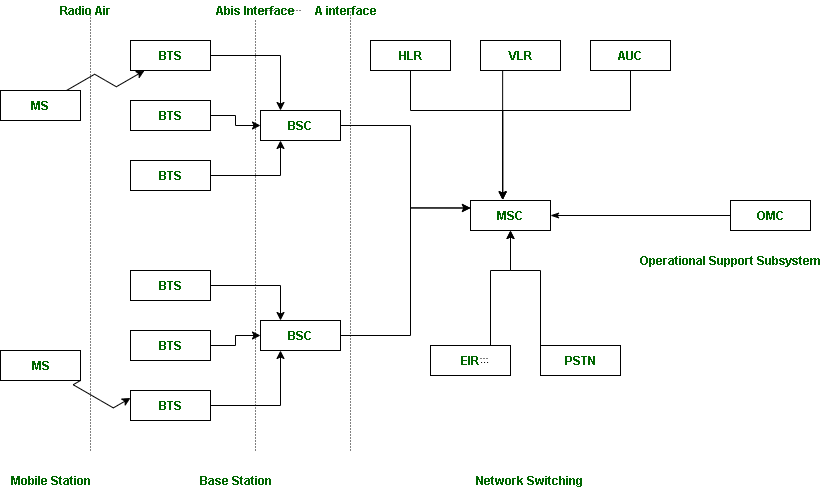GSM

GSM in Wireless Communication
GSM stands for Global System for Mobile Communication. GSM is an open and digital cellular technology used for mobile communication. It uses 4 different frequency bands of 850 MHz, 900 MHz, 1800 MHz and 1900 MHz . It uses the combination of FDMA and TDMA. This article includes all the concepts of GSM architecture and how it works.
GSM is having 4 different sizes of cells are used in GSM :
Macro : In this size of cell, Base Station antenna is installed.
Micro : In this size of cell, antenna height is less than the average roof level.
Pico : Small cells’ diameter of few meters.
Umbrella : It covers the shadowed (Fill the gaps between cells) regions.
Features of GSM are :
Supports international roaming
Clear voice clarity
Ability to support multiple handheld devices.
Spectral / frequency efficiency
Low powered handheld devices.
Case of accessing network
International ISDN compatibility.
GSM is nothing but a larger system which is divided into further 3 subsystems.
BSS : BSS stands for Base Station Subsystem. BSS handles traffic and signaling between a mobile phone and the network switching subsystem. BSS having two components BTS and BSC.
NSS : NSS stands for Network and Switching Subsystem. NSS is to core network of GSM. That carried out call and mobility management functions for mobile phone present in network. NSS have different components like VLR, HLR and EIR.
OSS : OSS stands for Operating Subsystem. OSS is a functional entity which the network operator monitor and control the system. OMC is the part of OSS.
Suppose there are 3 Mobile stations which are connected with the tower and that tower is connected to BTS through TRX, then further connected to BSC and MSC. Let’s understand the functionality of different components.
1. MS : MS stands for Mobile System. MS comprises user equipment and software needed for communication with a mobile network. Mobile Station (MS) = Mobile Equipment(ME) + Subscriber Identity Module (SIM). Now, these mobile stations are connected to tower and that tower connected with BTS through TRX. TRX is a transceiver which comprises transmitter and receiver. Transceiver has two performance of sending and receiving.
2. BTS : BTS stands for Base Transceiver Station which facilitates wireless communication between user equipment and a network. Every tower has BTS.
3. BSC : BSC stands for Base Station Controller. BSC has multiple BTS. You can consider the BSC as a local exchange of your area which has multiple towers and multiple towers have BTS.
4. MSC : MSC stands for Mobile Switching Center. MSC is associated with communication switching functions such as call setup, call release and routing. Call tracing, call forwarding all functions are performed at the MSC level. MSC is having further components like VLR, HLR, AUC, EIR and PSTN.
VLR : VLR stands for Visitor Location Register. VLR is a database which contains the exact location of all mobile subscribers currently present in the service area of MSC. If you are going form one state to another state then your entry is marked into the database of VLR.
HLR : HLR stands for Home Location Register. HLR is a database containing pertinent data regarding subscribers authorized to use a GSM network.. If you purchase SIM card from in the HLR. HLR is like a home which contains all data like your ID proof, which plan you are taking, which caller tune you are using etc. OMC : OMC stands for Operation Maintenance Center. OMC monitor and maintain the performance of each MS, BSC and MSC within a GSM system.
AUC : AUC stands for Authentication Center. AUC authenticates the mobile subscriber that wants to connect in the network.
EIR : EIR stands for Equipment Identity Register. EIR is a database that keeps the record of all allowed or banned in the network. If you are banned in the network them you can’t enter the network, and you can’t make the calls.
PSTN : PSTN stands for Public Switched Telephone Network. PSTN connects with MSC. PSTN originally a network of fixed line analog telephone systems. Now almost entirely digital in its core network and includes mobile and other networks as well as fixed telephones. The earlier landline phones which places at our home is nothing but PSTN.
Three subsystem BSS, NSS and OSS are connected with each other via some interfaces. Total three interfaces are there:
Air Interface : Air interface is also known as UM interface. Interface between MS and BTS is called as UM interface because it is mobile analog to the U interface of ISDN.
Abis Interface : It is a BSS internal interface linking with BTS and BSC.
A interface : It provides communication between BSS and MSC
